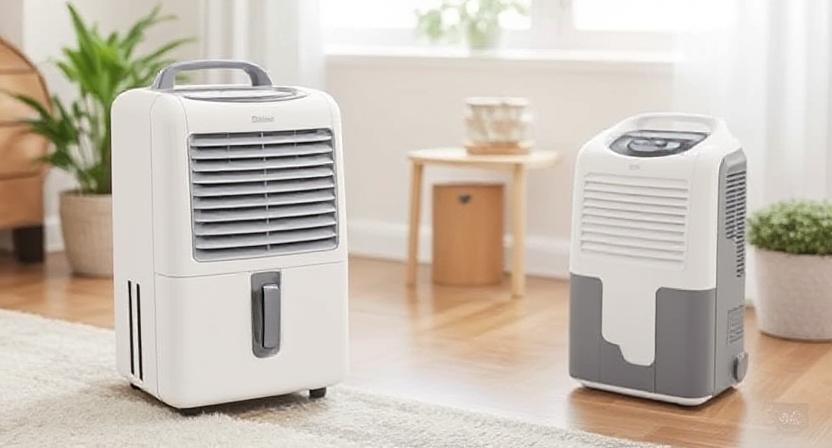📌 Why Portable Dehumidifiers in 2025 Matter for Indian Readers
Portable dehumidifiers are crucial in Indian homes—especially during the humid monsoon season when indoor humidity often soars above 75%, promoting mould, mildew, and respiratory issues. Maintaining indoor humidity between 45% and 55% ensures comfort, improves air quality, and protects health.
By 2025, demand for portable solutions had surged, thanks to growing awareness of indoor air quality and technological improvements. India’s overall dehumidifier market reached USD 177.8 million in 2023 and is projected to grow at ~8% CAGR to reach over USD 303 million by 2030. Meanwhile, the Asia Pacific portable dehumidifier market reached USD 606 million in 2024 and is expected to expand at 6% CAGR to nearly USD 1 billion by 2032.
✅ Benefits of Portable Dehumidifiers in India
A portable dehumidifier brings a host of benefits:
Health & Comfort
-
Improves air quality, reduces musty odours and mold spores
-
Reduces respiratory risk, allergies, and damp-induced issues
Home & Asset Protection
-
Prevents mold damage to walls, furniture, clothes, and electronics
-
Reduces rust and damp patches, prolonging lifespan of possessions
Energy & Climate Comfort
-
Makes warm, humid environments feel cooler by reducing “wet-bulb temperature”—the sticky discomfort of heat
-
More energy‑efficient than running AC constantly
🧰 Choosing the Right Portable Dehumidifier in 2025
Table: Key Features Compared
| Feature | Why It Matters for Indian Homes | What to Look For |
|---|---|---|
| Capacity (L/day) | Suits room size & humidity level | 10‑20 L/day for bedrooms; larger for living areas |
| Technology | Most efficient for Indian climate | Desiccant technology is the fastest‑growing. |
| Tank Size & Drainage | Longer run times, less emptying | ≥4 L tank or continuous drainage option |
| Noise Level | Living comfort in bedrooms/living rooms | Voice‑quiet units (< 40 dB) |
| Energy Efficiency | Lower electricity bills | Energy Star / efficient compressor models |
| Portability | Easy movement across rooms and seasonal storage | Wheels, handles, compact size |
| Additional Features | Hygrostat control, auto shut‑off, washable filters | Smart sensors, auto-restart, filter alerts |
🏠 Real‑World Use Cases in Indian Homes
-
Monsoon Relief: In cities like Mumbai or Kochi, indoor RH spikes during monsoon. A portable dehumidifier can maintain safe humidity levels and prevent mould buildup in closets or basements.
-
Hill Station Homes: Places like Ooty or Shillong experience persistent dampness even when temperatures are moderate—dehumidifiers eliminate moisture buildup, enhancing living comfort.
-
Single‑room Apartments / Rentals: Compact units (10 L/day) fit tight spaces and are ideal for renters or temporary homes.
📈 India Portable Dehumidifier Market Trends & Statistics
-
India Dehumidifier Market: Estimated at USD 177.8 million in 2023; projected to hit USD 303 million by 2030 at ~8% CAGR.
-
Portable Market: The Asia-Pacific portable dehumidifier market stood at USD 606 million in 2024 and is expected to reach nearly USD 1 billion by 2032 at 6% CAGR.
-
Technology Shift: Desiccant-based units dominate in the Indian climate due to quicker performance at lower temperatures.
🛒 Top Portable Dehumidifier Features Trending in 2025
-
Compact & lightweight designs with easy mobility
-
Smart humidity sensors and auto-hygrostat controls
-
Quiet operation (< 35 dB) for uninterrupted sleeping
-
Washable filters and user alerts for maintenance
-
Continuous drainage options if the unit will run for long periods
🌟 Feature‑Based Buying Guide: Step by Step
-
Measure your room size and typical humidity
-
Select capacity (e.g. , 10 L/dayfor small rooms, 20 L/day+for larger areas)
-
Choose technology: desiccant for efficient performance, refrigerative for larger volume
-
Review portability: wheels, handle, size
-
Check energy rating to minimize monthly bills
-
Assess noise level if using in bedrooms (look for “quiet operation”)
-
Consider maintenance needs: tank size, auto-off, filter replacement
📊 Example Table: Compact vs High‑Capacity Units
| Model Type | Capacity (L/day) | Coverage (sq ft) | Noise (dB) | Approx. Price (₹) |
|---|---|---|---|---|
| Compact Unit | ~10 | 150–200 | ~35 | 10,000–15,000 |
| Mid-range Desiccant | ~20 | 300–400 | ~40 | 25,000–30,000 |
| High‑Capacity Unit | 30–50 | 500+ | ~45–50 | 35,000–45,000 |
💡 Actionable Tips to Maximize Benefits
-
Run the dehumidifier during peak humidity hours (e.g., early morning during monsoon).
-
Place near moisture sources: bathrooms, kitchens, and basements.
-
Regularly empty the tank or set up a drainage hose for continuous use.
-
Clean or rinse the filter monthly to maintain airflow and efficacy.
-
Combine with good ventilation and fans to balance cooling needs.
✅ Conclusion: Ready for Portable Dehumidifiers in 2025?
Portable dehumidifiers are essential tools for Indian homes in 2025. They offer improved indoor air quality, health benefits, and protection against mould and damage, all while maintaining energy efficiency and comfort.
With the Indian market growing steadily and more feature-rich, quiet, and smart models becoming available, it’s easier than ever to adopt a reliable portable dehumidifier tailored to your space.
👉 Call-to-Action
Whether you’re facing the monsoon moisture or dampness in hill retreats, choose a portable dehumidifier today—one that fits your room size, humidity levels, and usability needs.
Upgrade your home’s comfort and health—browse trusted models, compare capacities like 10 L/day or 20 L/day desiccant options, and order a portable dehumidifier from a reputable brand now!
Feel free to reach out for personalised model suggestions based on your room size and humidity requirements.
